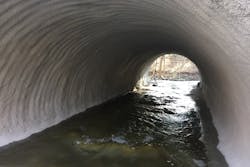Liner provides cost-effective culvert repair
The city of Troy, Mich., is located among Metropolitan Detroit’s northern suburbs in Oakland County. It currently maintains a network of more than 350 miles of local, major and county roads under the jurisdiction of its public works department.
The city has a regular inspection program for its storm culverts and bridges. During recent inspections in 2013 and 2015, severe corrosion of the inverts of twin arched corrugated metal pipe (CMP) culverts—built in 1967 under Wattles Road and extended in 1983—was observed. The city began to investigate solutions to ensure that the culverts remained structurally sound. The 127-mile Rouge River runs through the culverts on its path to the Detroit River and can flow full in times of heavy rains and snow melts. The twin culverts were designed as CMP steel arch pipes with a nominal size of 12 ft 10 in. wide by 8 ft 4 in. tall. The combined length of the two pipes was approximately 170 ln ft.
When the city began to explore its options for the structure, it originally planned to replace the twin culverts with a span bridge, because most conventional rehabilitation solutions—such as cured-in-place pipe or slip-lining—typically are not feasible or cost-effective.
Solution
The project consisted of twin structures, so an internal bypass through one of the pipes was constructed while the other was rehabilitated, minimizing traffic disruption. Once the bypass was established, the first pipe was cleaned and pressure-washed and then repaired using a hand-spray method due to the large diameter of the pipe. The work was executed in late November and December, thus the pipes were isolated and heated to prevent freezing of the material during the first six hours of curing.
Results
Application of the liner was performed over a period of approximately three weeks with multiple passes with 0.5 to 1 in. of mortar applied at a time to optimize the work process and efficiency.
A local third-party certified laboratory sampled material during most of the spray applications for quality control and adherence to the project specification. The completed project allowed the city to both save money and avoid a dig-and-replace construction that would have disrupted the local traffic and closed the road for an extended period of time.
